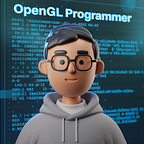OpenGL’s Depth Buffer for 3D Rendering
Welcome back to our OpenGL adventure! So far, we’ve learned how to draw shapes, move them around, and even animate them. Now, we’re going to dive into something super cool: making our scenes look 3D! To do that, we need to learn about a special tool in OpenGL called the depth buffer.
What is the Depth Buffer?
Imagine you’re in a crowded room, trying to see your friend who’s standing far away. People close to you might block your view, and you can’t see your friend clearly. The depth buffer in OpenGL helps solve a similar problem, but with 3D shapes. It keeps track of which objects are in front and which are behind, so OpenGL knows which shapes to draw first.
Without a depth buffer, objects might not look right because shapes that are supposed to be behind other shapes might accidentally be drawn on top. The depth buffer makes sure everything is drawn correctly, just like how your eyes help you see things in the right order.
Setting Up the Depth Buffer
To use the depth buffer in OpenGL, we need to turn it on and tell OpenGL to use it when drawing our shapes.
Here’s how you can do that:
In this code, we added glEnable(GL_DEPTH_TEST); in the init() function to turn on the depth buffer. This tells OpenGL to start keeping track of depth, which means it will know which shapes should be in front and which should be behind.
We also use glClear(GL_COLOR_BUFFER_BIT | GL_DEPTH_BUFFER_BIT); in the display() function. This clears both the color buffer (which controls what you see on the screen) and the depth buffer before drawing each new frame. It’s like wiping the slate clean before you start drawing.
Drawing in 3D
With the depth buffer turned on, we can start drawing 3D shapes! In the code above, we drew two cubes, one closer to the camera and one further away. Thanks to the depth buffer, OpenGL knows to draw the closer cube in front of the further one, making it look like the cubes are in 3D space.
But how do we make our shapes look 3D? We use something called coordinates. In 2D, we use X and Y coordinates to place our shapes. In 3D, we add a third coordinate called Z, which tells OpenGL how far away the shape is. The further back the shape is, the smaller it appears, just like in real life!
Why is the Depth Buffer Important?
The depth buffer is super important for making 3D scenes look right. Without it, shapes might overlap in weird ways, and your 3D scene would look confusing. The depth buffer helps OpenGL draw everything in the correct order, so your scene looks realistic.
Experimenting with Depth
Now that you know how to use the depth buffer, try experimenting with different shapes and positions. What happens if you put a shape very far away? Or if you put two shapes at the same depth? Playing around with these settings will help you understand how depth works in OpenGL.
Conclusion
Using the depth buffer in OpenGL is like giving your scene superpowers! It helps OpenGL understand which shapes are closer and which are further away, making your 3D scenes look just right. With the depth buffer on your side, you’re ready to start creating awesome 3D graphics.
Related Posts:
- Creating Your First OpenGL Scene: Drawing Primitives in C++
- Animating Your OpenGL Scene: Basic Movement and Rotation
- Understanding the OpenGL Pipeline: A Beginner’s Guide
- Transformation in OpenGL: Translation, Rotation and Scaling
- Handling Input in OpenGL: Keyboard and Mouse Controls
- Camera System in OpenGL with Perspective Projection
- Texture Mapping: Applying Textures to a Cube in OpenGL
